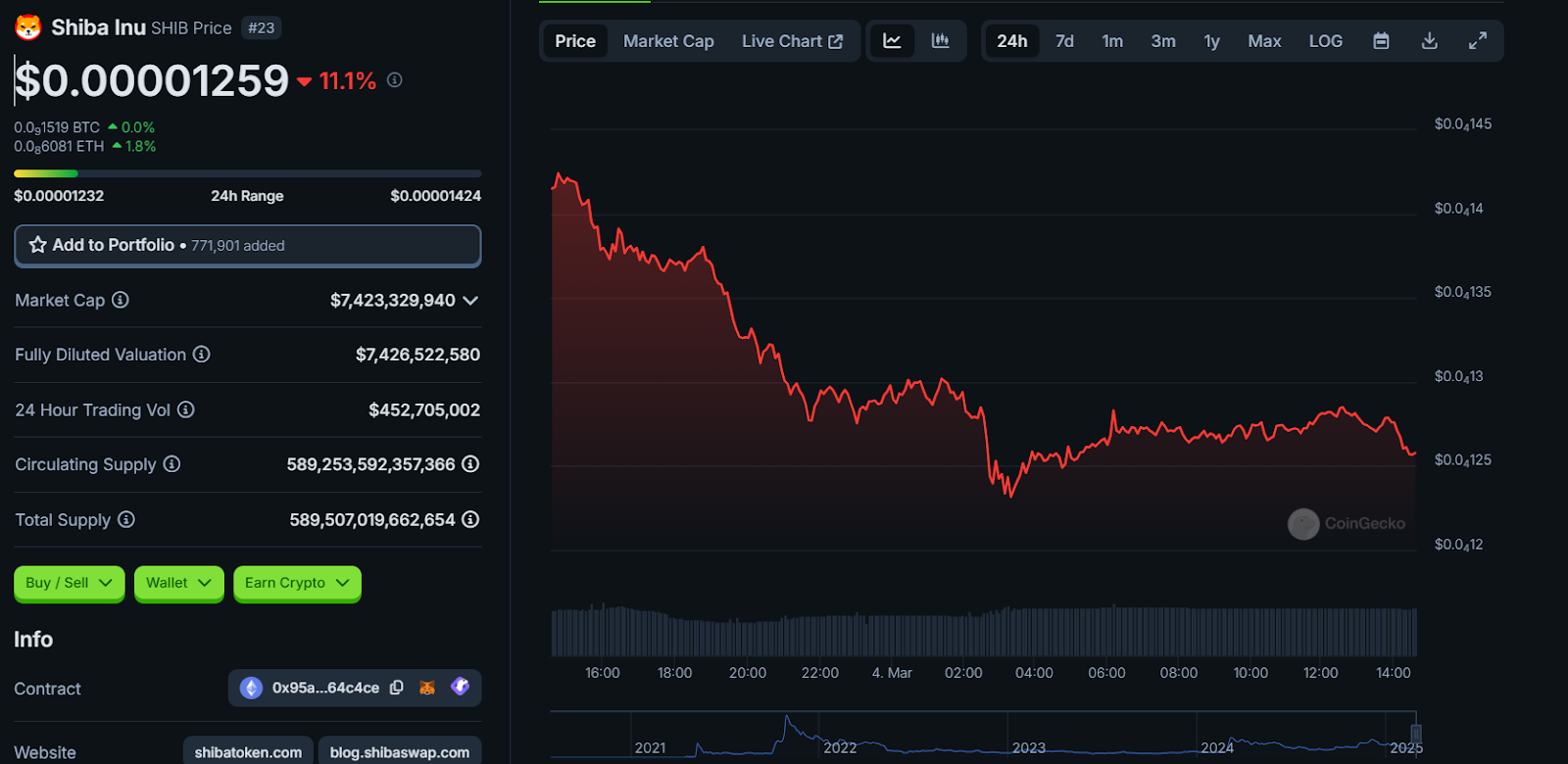
The post Sharp Shiba Inu (SHIB) and Rexas Finance (RXS) Pump Incoming as Bitcoin (BTC) Aims for $125,000 appeared first on Coinpedia Fintech News
Bitcoin’s (BTC) move toward $125,000 is causing waves throughout the crypto market, with Shiba Inu (SHIB) and Rexas Finance (RXS) emerging as top competitors for spectacular gains. While SHIB’s recent surge resulted from President Donald Trump’s recent announcement on US crypto reserve assets, Rexas Finance is upsetting the asset management business by bringing unprecedented liquidity to previously illiquid markets. Investors are closely monitoring both assets, anticipating significant increases.
Shiba Inu Soars Amid Trump’s Latest Announcement
Shiba Inu retraced 11% in 24 hours after rising 20%, staying above $0.000012. The recent surge followed Donald Trump’s declaring the opening of a crypto reserve with big-league tokens, including Bitcoin, Ethereum, Solana, Ripple, and Cardano.

Shiba Inu Price Chart (24-Hour), Mar. 4, 2025 | Source: CoinGecko
Despite the harsh reversal, technical indications suggest a favorable outlook. Analysts believe a breach above $0.000015 might boost SHIB to $0.000017, and some investors anticipate a 500% breakthrough to $0.000020 and beyond. Crypto analyst Crypto Elites highlighted a cup-and-handle pattern that, if confirmed, may spark a 12x surge to $0.000183. As the market prepares for a bullish breakout, Shiba Inu is poised for a giant boost in the coming weeks.

Rexas Finance (RXS) Introduces Liquidity to Illiquid Markets, Setting the Stage for a Massive Rally
Rexas Finance (RXS) is disrupting asset management by addressing a long-standing issue: a lack of liquidity in historically illiquid sectors. RXS uses blockchain to facilitate tokenizing real-world assets (RWAs) like real estate, commodities, and financial instruments, giving users access to a trillion-dollar market.
Rexas Finance’s fundamental function is to simplify asset tokenization. For example, by purchasing RXS-backed tokenized shares, an investor can now own a portion of a $10 million commercial property for just $100. This kind of fractional ownership enables small-scale investors to access high-value asset markets previously only available to institutions.
To achieve this, Rexas Finance has built a rich tokenization ecosystem and DeFi features that boost liquidity, accessibility, and investment returns. The Rexas Token Builder and QuickMint Bot simplify token creation without technical experience. Meanwhile, the Rexas Launchpad offers early-stage investment opportunities in new cryptocurrency projects, and the Rexas Treasury helps investors maximize returns through automated yield farming. This novel technique has created tremendous investor interest, hastening the RXS presale to near completion. In its last step (step 12), 91% of the allocated tokens have already been sold, indicating increased FOMO among investors. RXS is selling at $0.20, up 566% from $0.03 in Stage 1.
The presale, which sold 455 million tokens and garnered $47 million, is expected to be one of 2025’s most significant achievements. Rexas Finance also holds a $1 million giveaway to reward early investors. With over 1.5 million entries received so far, the top 20 participants will earn $50,000 worth of RXS. This event will further increase Rexas Finance’s appeal among crypto enthusiasts. The larger picture of Rexas Finance revolves around its upcoming exchange listings.
On June 19, RXS will debut on at least three of the top ten global crypto exchanges, enhancing liquidity, market exposure, and institutional interest. The initial listing price is $0.25, and analysts predict a potential 100,000% post-launch jump due to rising adoption and exchange-driven demand.
Conclusion: SHIB and RXS Poised for Explosive Gains
Shiba Inu (SHIB) and Rexas Finance (RXS) are poised for significant gains as Bitcoin (BTC) nears $125,000. With SHIB seeing a 300% spike in whale demand and RXS revolutionizing real-world asset tokenization, both assets are expected to experience significant price changes. The Rexas Finance presale is practically sold out (9% to go), and its June 19 market debut will likely cause a price explosion. This is the last chance for investors to secure RXS at presale prices before it goes public—act immediately before the opportunity passes!
For more information about Rexas Finance (RXS) visit the links below:
Website: https://rexas.com
Win $1 Million Giveaway: https://bit.ly/Rexas1M
Whitepaper: https://rexas.com/rexas-whitepaper.pdf
Twitter/X: https://x.com/rexasfinanceTelegram: https://t.me/rexasfinance






